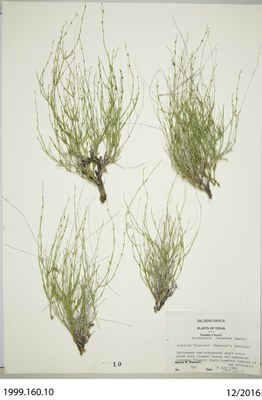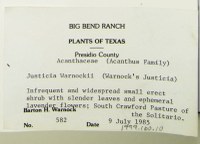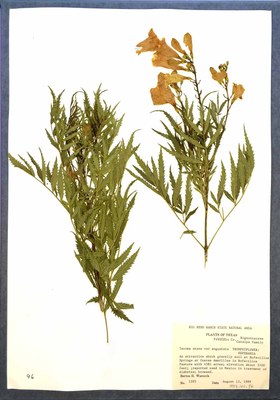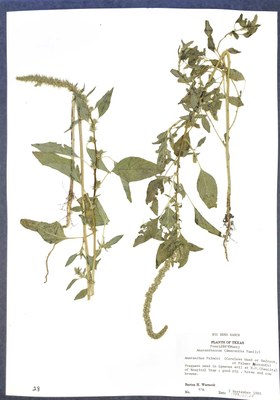Herbarium Specimen
 Barton Warnock and his students at Sul Ross University roamed the Big Bend region for three decades studying and collecting plants. They collected samples of branches, leaves and seeds. They recorded where they found the plants as well as how local people and animals used the plants.
Barton Warnock and his students at Sul Ross University roamed the Big Bend region for three decades studying and collecting plants. They collected samples of branches, leaves and seeds. They recorded where they found the plants as well as how local people and animals used the plants.
How is it made?
Scientists press and dry plant samples (like these cuttings of Warnock’s water willow) to preserve them. After the plants are dry, the samples are attached to an acid-free backing board. The label records information on species, location, date collected, and other facts noted when collected.
Why do we keep pressed plants?
 A herbarium is like a library of preserved plants. Scientists such as botanists, ecologists and ethnobotanists can study rare, endangered, or extinct plants as well as invasive species. They use herbarium specimens to track changes in the environment over time.
A herbarium is like a library of preserved plants. Scientists such as botanists, ecologists and ethnobotanists can study rare, endangered, or extinct plants as well as invasive species. They use herbarium specimens to track changes in the environment over time.
The Barton Warnock Visitor Center houses Dr. Warnock’s collection of plant specimens from Big Bend Ranch State Park. He collected plants from the late 1970s through the early 1990s. The 1,692 dried and pressed plant specimens represent the botanical diversity of the over 300,000-acre state park.
Become a citizen scientist
Herbariums are moving into the digital world. Next time you walk in your neighborhood or through a state park, take a photo of a plant. Your digital camera will record the GPS coordinates of where you took the picture.
Share your photo on an app like iNaturalist. These apps are virtual herbariums, where citizen scientists work with professional scientists to study the natural world.


